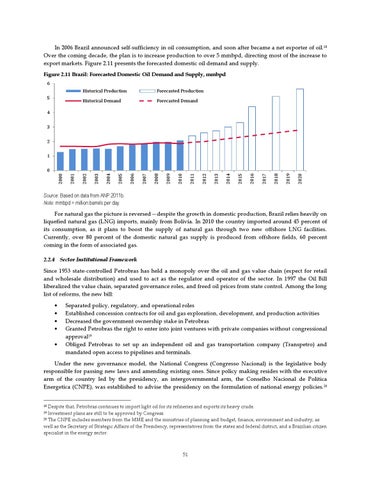In 2006 Brazil announced self-sufficiency in oil consumption, and soon after became a net exporter of oil.18 Over the coming decade, the plan is to increase production to over 5 mmbpd, directing most of the increase to export markets. Figure 2.11 presents the forecasted domestic oil demand and supply. Figure 2.11 Brazil: Forecasted Domestic Oil Demand and Supply, mmbpd 6 5
Historical Production
Forecasted Production
Historical Demand
Forecasted Demand
4 3 2 1
2020
2019
2018
2017
2016
2015
2014
2013
2012
2011
2010
2009
2008
2007
2006
2005
2004
2003
2002
2001
2000
0
Source: Based on data from ANP 2011b. Note: mmbpd = million barrels per day.
For natural gas the picture is reversed—despite the growth in domestic production, Brazil relies heavily on liquefied natural gas (LNG) imports, mainly from Bolivia. In 2010 the country imported around 45 percent of its consumption, as it plans to boost the supply of natural gas through two new offshore LNG facilities. Currently, over 80 percent of the domestic natural gas supply is produced from offshore fields, 60 percent coming in the form of associated gas. 2.2.4 Sector Institutional Framework
Since 1953 state-controlled Petrobras has held a monopoly over the oil and gas value chain (expect for retail and wholesale distribution) and used to act as the regulator and operator of the sector. In 1997 the Oil Bill liberalized the value chain, separated governance roles, and freed oil prices from state control. Among the long list of reforms, the new bill:
Separated policy, regulatory, and operational roles Established concession contracts for oil and gas exploration, development, and production activities Decreased the government ownership stake in Petrobras Granted Petrobras the right to enter into joint ventures with private companies without congressional approval19 Obliged Petrobras to set up an independent oil and gas transportation company (Transpetro) and mandated open access to pipelines and terminals.
Under the new governance model, the National Congress (Congresso Nacional) is the legislative body responsible for passing new laws and amending existing ones. Since policy making resides with the executive arm of the country led by the presidency, an intergovernmental arm, the Conselho Nacional de Politica Energetica (CNPE), was established to advise the presidency on the formulation of national energy policies.20
Despite that, Petrobras continues to import light oil for its refineries and exports its heavy crude. Investment plans are still to be approved by Congress. 20 The CNPE includes members from the MME and the ministries of planning and budget, finance, environment and industry, as well as the Secretary of Strategic Affairs of the Presidency, representatives from the states and federal district, and a Brazilian citizen specialist in the energy sector. 18 19
51
